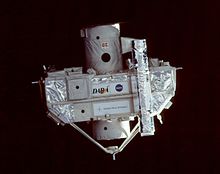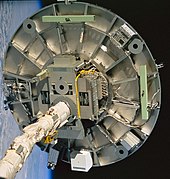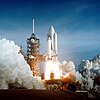STS-80
| Mission emblem | |||
|---|---|---|---|

|
|||
| Mission dates | |||
| Mission: | STS-80 | ||
| COSPAR-ID : | 1996-065A | ||
| Crew: | 5 | ||
| Begin: | November 19, 1996, 19:55:47 UTC | ||
| Starting place: | Kennedy Space Center , LC-39B | ||
| Landing: | December 7, 1996, 11:49:06 UTC | ||
| Landing place: | Kennedy Space Center, Lane 33 | ||
| Flight duration: | 17d 15h 53min 18s | ||
| Earth orbits: | 279 | ||
| Rotation time : | 91.6 min | ||
| Orbit inclination : | 28.4 ° | ||
| Apogee : | 358 km | ||
| Perigee : | 347 km | ||
| Covered track: | 11.2 million km | ||
| Payload: | ORFEUS-SPAS-2 , WSF-3 | ||
| Team photo | |||
 v. l. No. Kent Rominger, Tamara Jernigan, Story Musgrave, Thomas Jones, Kenneth Cockrell |
|||
| ◄ Before / After ► | |||
|
|||
STS-80 ( English S pace T ransportation S ystem) is a mission designation for the US space shuttle Columbia ( OV -102) of NASA . The launch took place on November 19, 1996. It was the 80th space shuttle mission and the 21st flight of the Columbia space shuttle.
team
- Kenneth Cockrell (3rd space flight), commander
- Kent Rominger (2nd space flight), pilot
- Tamara Jernigan (4th spaceflight), mission specialist
- Thomas Jones (3rd space flight), mission specialist
- Story Musgrave (6th space flight), mission specialist
Musgrave, who was 61 at the time of the flight, was the second astronaut to complete six space flights after John Young (1983).
Mission description
The last shuttle flight in 1996 was particularly interesting in terms of flight technology. During the mission, the satellites ORFEUS-SPAS-2 and WSF-3 were released and later recaptured. The two satellites were not allowed to approach each other too far, otherwise the experiments could be disrupted. In addition, two exits for Jernigan and Jones were planned for about 6 hours each on the 10th and 12th day of the flight. The aim was to test new tools and a crane that would be used to build the International Space Station . Both exits had to be canceled, however, as the outer hatch could not be opened.

ORFEUS (Orbiting and Retrievable Far and Extreme Ultraviolet Spectrograph) is a complex of astronomical instruments mounted on a Pallet Satellite (SPAS). The main payload is the 1-meter reflector telescope ( focal length 2.4 meters) and two UV spectrographs , the Far Ultraviolet Spectrograph for wavelengths in the 90–125 nm range and the Extreme Ultraviolet Spectrograph , which examines light with wavelengths from 40 to 115 nm. The surfaces of particularly large and hot stars, the corons of sun-like stars, the cooling mechanisms of white dwarf stars , the nature of accretion disks around collapsed stars and binary star systems , supernova remnants, active galaxies, interstellar matter and potential star formation areas were examined. A plane mirror is used to switch between the two spectrographs . Then the light is spectrally split up by means of a reflection grating and directed onto detectors . During the two-week free flight, more than 100 interesting objects were examined carefully. Also on board the Shuttle Pallet Satellite were a simulation device for the European spacecraft ATV , an experiment to demonstrate an optical rendezvous sensor (both ATV Rendezvous Pre-Development Project ), a metal salt electrolysis experiment by German students ( Student Experiment on Astro-SPAS ) , an apparatus for determining the surface changes of optical glasses and detector materials during a space flight ( Surface Effects Sample Monitor ) and a spectrograph for observing extremely bright galactic objects ( Interstellar Medium Absorption Profile Spectrograph IMAPS). The latter allows the study of the fine structure of the spectra of interstellar gases . This allows their speed to be determined with an accuracy of 1.6 kilometers per second. ORFEUS was deployed on the first day of flight and anchored on board again on the 16th. The Space Vision System was used for this. It consists of a series of cameras and markings inside the shuttle's cargo bay. The markings make it easier to assess the position and location of large, unclear payloads.

The 2.3 tonne Wake Shield Facility satellite completed its third mission. The shield flying ahead has a diameter of about 3.6 meters and creates a particularly good vacuum in its shadow. Seven thin films of III-V compound semiconductors , for example aluminum gallium arsenide and indium gallium arsenide , were epitaxially produced here. WSF was released on the fourth day of flight and recaptured on the seventh. One day later it was held out of the cargo bay for a few hours to investigate the formation of an aluminum oxide film ( Atomic Oxygen Processing Experiment ). This is caused by a chemical reaction between the aluminum and the atomic oxygen in the upper atmosphere .
Medical-biological examinations were carried out on behalf of the National Institute of Health of the USA (R4 and C6). Calcium metabolism and vascular function were studied in laboratory rats. In previous missions, it was found that increased calcium intake from food not only affects the breakdown of bone substance, but also lowers blood pressure and cholesterol levels . The regulation of blood pressure was the subject of this mission. Seven genetically modified rats were treated with different doses of calcium. As a result of the genetic manipulation , all animals suffered from high blood pressure . The second experiment in this context concerned bone formation in weightlessness . The growth factor TGF-b plays a major role in this. It is formed in bone cells and is important for communication between the cells. In weightlessness, however, the TGF-b gene is not as active as it is on earth. After the flight, however, the formation of TGF-b normalizes very quickly. Both effects were studied in genetically modified human bone cells during and after the STS-80 mission. These cells develop at temperatures around 16 ° C, but mature into bone mass at higher temperatures. The role of hormones was also examined .
Commercial medical-biological experiments by the University of Alabama in Huntsville (UAH) and the company Instrumentation Technology Associates (ITA) concerned, among other things, the development of a diabetes treatment , the recording of cell reactions in weightlessness, the development of gene combinations that are toxic to insects for but other organisms are not harmful, the production of urokinase - protein crystals against breast cancer and testing of a chemically robust sealing material. The equipment complex included 3 automated laboratories in the middle deck of the Columbia, in which more than 900 experiments were carried out.
Further equipment was housed in the space shuttle's cargo bay . In this way, the influence of microgravity on genetically modified tomato and tobacco seedlings was examined. Several genes from soybeans were implanted as molecular markers . The research focused on the transport and distribution of hormones in plants and the rate at which plants grow. A total of 200 seedlings were housed in 22 Petri dishes and distributed over 5 canisters (Biological Research in Canisters). For analysis on the ground, some plants were colored or frozen.
The samples that were on board the Columbia as part of an educational program ( Space Experiment Module ) were also mostly biological . Students of various age groups designed and built the experiments. So were algae , bones , footage, yeast , crabs , plant seeds , lime , popcorn and mosquito eggs carried. More demanding studies dealt, for example, with convection in liquids, heat conduction in copper, the behavior of immiscible liquids in weightlessness, measurements of gravity and acceleration, and the study of crystals . A particle detector was also part of the research complex.
Previous heat exchange systems work via a cooling liquid that transports the excess heat from the cabin to radiators . The cooling circuit is kept going by small pumps. However, a system in which the flow of liquid is driven by capillary forces without a motor could be more effective in the future. A corresponding system ( capillary pumped loop ) was tested during the mission. The behavior of the liquid and the resulting vapor were recorded for closer examination.
Columbia's 21st space flight was the longest in shuttle history. First of all, the free flight time of the ORFEUS satellite was extended by one day for further astronomical observations. Nevertheless, a planned landing was sought. This had to be postponed by two days due to bad weather at both possible landing locations and took place on December 7th in Florida on runway 33 in the Kennedy Space Center.
See also
Web links
- NASA Mission overview (English)
- Video summary with comments of the crew (English)
- Mission summary of NASA (English)
- NASA video of Mission (English)
